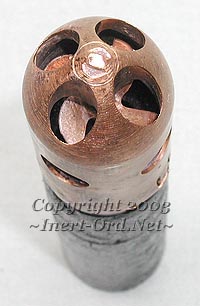
Austrian "Universal" Grenade - Impact or Delay Fuze

An interesting example of an attempt at a field-configurable munition. I believe this to be an early war development.
This multi-function grenade has impact and delay fuze features. I'm not sure from the diagram how this was used exactly, as it is a parts identification chart, not a users manual.
Some features to note:
• Internal propeller which extends the firing pin when air flows through the nose ports.
• Safety pin soldered in the removable brass cap which kept the propeller locked.
• Compressible nose assembly. On impact it breaks through two thin metal detents on the sides and allows the firing pin on the end of the prop to hit the percussion cap, but only if the prop has had time to spin and extend.
• Combination belt clip and drogue chute "suspension hook". This was removable and replaced with a rod for use as a rifle grenade.
• Internal fragmentation sleeve and exploder tube.
• Friction fuze attached to the side for use as a hand grenade.

Any help on how this was actually used would be appreciated


This is a lake recovered relic from the high mountain battlefields near the Austrian / Italian border and spent many decades in frozen water which contributed to its well preserved condition The thin sheet metal cap has been deformed and split in four places lengthwise from ice expansion over the years. Rare to find in any condition, especially with the cap.